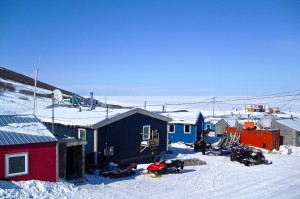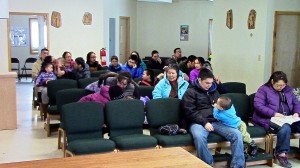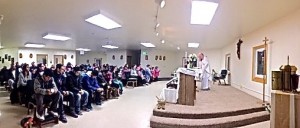by Bruce Morrill, Edward A. Mallory Chair of Catholic Studies

Back in 2000, while making the annual eight-day silent retreat required of us Jesuits, I found myself moved to offer pastoral service, as my schedule might allow, to Yup’ik Eskimo villages along the Bering Seacoast of Southwest Alaska. I had been a Jesuit (lay) volunteer in a village on the Yukon Delta back in 1981-82, the year between my graduation from Holy Cross and entrance into the New England Province of Jesuits. A decade of “formation” (novitiate, studies in philosophy and anthropology, high-school teaching, and divinity school), followed by doctoral studies led to my tenure-track appointment at Boston College in 1996. By the summer of 2000, with three books and several articles published, my tenure case was in good shape, giving me room to breathe pastorally, whereupon Holy Breath (aka, the Holy Spirit) blew me across the continent to villages on Alaska’s Yukon-Kuskokwim Delta annually, sometimes semi-annually, from 2000 to 2010.

My move from Boston College (a Catholic institution taking several days off before and after Easter Sunday) to Vanderbilt Divinity School (with only Good Friday off) has over the past few years prevented my getting away for the nine days needed to assure service from Palm Sunday through Easter Sunday. The airfares are expensive (taking jets as far as the mega-village of Bethel, then prop jobs out to the villages), total travel time runs approximately 20 hours in each direction, and one must account for weather conditions delaying flights in or out of the villages, served as they are by small propeller planes on gravel airstrips. This year my good fortune being on leave in a visiting chair at Fordham University (another Catholic institution) afforded me the opportunity to get away for Holy Week and Easter to Scammon Bay—population 474, 96 percent Yup’ik residents, 49 percent age 18 and younger, of whom 49 percent live below the poverty line.
This was my first visit to Scammon (per the decision of the Jesuit superior in that region, who with just four other priests has responsibility for nearly twenty villages, none of which are connected by roads). My numerous prior experiences of contemporary Yup’ik culture eased my entry into the living conditions, the social conventions, religious and ritual patterns of practice, the beautiful and tragic characteristics of a people caught between American techno-consumer culture and their indigenous heritage. Parishioners were grateful to have a priest for the series of liturgies beginning with Palm Sunday, followed by daily masses for the first half of Holy Week, and then the most important liturgy of the year, the three-day Paschal Triduum comprised of the Thursday evening Mass of the Lord’s Supper, Friday evening Liturgy of the Lord’s Passion, and Saturday night Easter Vigil, followed finally by an Easter Sunday morning Mass that included baptisms.

Participation at the Palm Sunday and then Paschal Triduum and Easter morning services were full (seating capacity 100), with various members at ease taking up the roles of lectors (proclaiming scripture readings), music leadership, and other smaller ritual parts and forms of assistance—all done with minimal-to-no rehearsal or preparation. Knowing the latter simply not to be part of the Yup’ik way, I am always gently challenged to set aside my own need for carefully planned execution. Any and all ritual in Yup’ik culture is a matter of process taking its own time, finding its own way, tapping into customary patterns from past practice and, ever so slightly, making room for slight innovations. While quick to adopt the ever-changing means of communication (cell phones, dish television), travel (advances in snowmobiles and four-wheeler ATVs), and commercial culture (styles of jeans and sneakers, professional sports logoed apparel, pop music), the people take a highly conservative approach to religion, a syncretistic blend of Roman Catholic and indigenous rituals, symbols, myths, and beliefs comprising the present state of their tradition.
Preaching is one of the greatest yet most rewarding challenges each time I serve a village. Narrative is crucial, since Yup’ik linguistic thought processes are fiercely practical and adverse to abstraction. Thus, I find myself tapping into stories I’ve amassed either from listening to the experiences and traditional tales people have shared with me or from my own growing repertoire of events worth recounting from now years of pastoral visits among the villages. Regularly people request “house blessings,” invitations for the priest prayerfully to douse the walls and family members present with holy water, which always prove occasions for inquiring into the troubles being suffered, the worries sustained, as well as often for celebrating with the elderly the sacrament for anointing the sick.

My recent ten days in Scammon Bay proved no exception to such pastoral calls; indeed, more than once I listened to a parent’s heartbreak over a teenager or young adult’s suicide. But there is also much gentle humor and eager desire to share traditional foods (dried fish, seal oil, fried bread), Eskimo dancing (I became quite adept back in 1981-82), occasional invitations on hunting or fishing expeditions, and even overnight stays at family fish camps (tents on the tundra) when I’ve been able to visit in summer. Privileged by the welcome into their lives, I do my best to make a return-gift by delivering homilies and leading prayer wherein the divine works of creation and redemption might come into a bit clearer light among a people accustomed to celebrating life yet not unacquainted with long stretches of darkness.